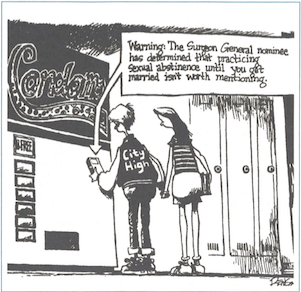Madonna posters come down in wake of Catholic League protest
Offensive ads depicting pop star Madonna and the Virgin Mary and Infant Jesus quickly came down from New York City public buses and telephone booths in the wake of a firestorm of protest initiated by the Catholic League in late September.
The ads, which bore the legend “The difference between you and your parents,” promoted VH-1, the video music sister channel to MTV. Officials of VH-1 publicly apologized for the ads.
Catholic League president William A. Donohue challenged the appearance of the ads on buses operated by the Metropolitan Transit Authority (MTA), a public agency. In an open letter to New York mayor David Dinkins which was released to the news media on September 20, Donohue noted that an ad depicting the Blessed Mother and Jesus would have been rejected out of hand as “religious” but that the VH-1 ad was apparantly acceptable because the Catholic symbols were being blasphemed.
New York Post columnist Ray Kerrison was attracted by the story and in a page three article in the September 27 issue of the Post noted the offensiveness of the ads, the insensitivity of public officials, and the Catholic League’s bold challenge to the mayor.
By mid-morning on the 27th, TV and radio crews were tripping over each other as they trooped in and out of Catholic League headquarters. Interviews with League president Donohue were carried on every major TV outlet in the metropolitan area and distributed nationwide by network radio and TV affiliates as well as by syndicated shows like “Hard Copy” and “A Current Affair.” The League’s cries of protest were even carried on London radio where Madonna was appearing in a concert being panned by critics and in Toronto, Canada.
Metropolitan Transit Authority and phone company public relations personnel found themselves swamped with inquiries from the media and calls of protest from irate Catholics. Their official positions and explanations changed almost hourly as the firestorm of protest grew. Initially, MTA officials simply said that the ad met their “advertising guidelines” and were protected by the First Amendment. When it became clear that this lame excuse wasn’t working, the media was told that the posters were scheduled to come down in a few days anyway, so why was everyone getting all excited about them?
By mid-day on Tuesday, League officials knew that the battle had been won when TV crews attempting to cover the story reported back to the League that they were having difficulty finding a poster to film!
The story’s impact was clearly felt at the grass roots level. The Catholic League office was swamped with requests for membership information and Catholic League president Bill Donohue found himself an instant celebrity on the street. On Tuesday afternoon, in an effort to escape the media blitz for a few minutes, he went for a brief walk and stopped to buy a hot dog from a street vendor. While standing there, a complete stranger walked up to him and told him what a great job he was doing.
And the story clearly had impact well beyond the shores of the Hudson river. In Chicago – to cite just one example – the entire Catholic League news release on the Madonna poster was read and commented on for several minutes on WGN, arguably that city’s largest radio station in the middle of their top-rated morning “drive time” broadcast hosted by Bob Collins. A glance at the partial media listing (page 5, page 6) on the following pages makes it clear that the story made the news across the nation.
In follow-up interviews, after it became clear that the offensive posters were becoming scarce, Dr. Donohue made it clear that as far as the Catholic League was concerned, the situation was still not resolved. Donohue noted the League’s concern about the policies which had made the ad’s posting possible. Those guidelines were – and remain – clearly inadequate if they permit such blasphemy to be publicly displayed. Donohue asked that the person who ultimately approved this outrageous poster be identified. MTA officials have so far refused to comment.
